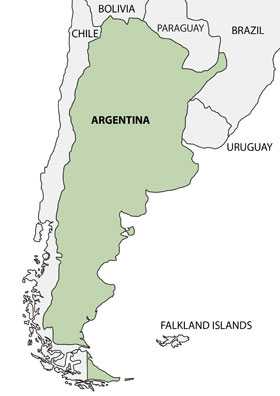Pertussis in Argentina
Español: La tosferina en la Argentina
On this Page

Overview
In December 2009, CDC-Latin American Pertussis Project conducted an initial assessment of the pertussis surveillance system and laboratory capacity in Argentina. Currently, Argentina’s Ministry of Health uses standardized data collection forms and case definitions for pertussis (known as coqueluche or tos convulsa). The national reference laboratories in Buenos Aires (Instituto Nacional de Enfermedades Infecciosas (INEI), part of the National Administration of Laboratories and Institutes of Health (ANLIS) “Dr. Carlos G. Marlbrán” [in Spanish]) and La Plata (Laboratorio Nacional de Referencia de Pertussis en Argentina Sede La Plata) have laboratory diagnostic capacity in culture, real-time and conventional polymerase chain reaction (PCR), and serology. All laboratories throughout the country use conventional PCR as the primary diagnostic for pertussis. Both the National Reference Laboratory and the laboratory in La Plata implemented real-time PCR in 2010 to confirm inconclusive results by conventional PCR, and to confirm Bordetella parapertussis and B. holmesii. In addition, INEI-ANLIS “Dr. Carlos G. Malbrán” tests for antimicrobial susceptibility to macrolides.
Case Definition
The case definition for a suspected case of pertussis includes three age groups:
- Under 6 months: All acute respiratory infections with at least one of the following symptoms:
- Apnea
- Cyanosis
- Respiratory stridor
- Posttussive vomiting
- Paroxysmal cough
- 6 months through 11 years: In the absence of a more likely diagnosis, a cough lasting at least 14 days with one or more of the following symptoms:
- Paroxysmal cough
- Respiratory stridor
- Posttussive vomiting
- Over 11 years: Cough for 14 days or more with or without any other symptoms.
Pertussis cases are confirmed if they meet the case definition and have positive laboratory confirmation (by culture, PCR, or serology) or are linked epidemiologically to a laboratory-confirmed case as specified in the Argentinian reporting guidelines (surveillance (laboratory) guidelines and surveillance guidelines [4 pages] [both in Spanish]). Argentina routinely uses real-time PCR to verify inconclusive conventional PCR results, and to confirm B. parapertussis and B. holmesii.
Vaccine Abbreviations
- DTP – Diphtheria and tetanus toxoids and whole cell pertussis vaccine
- Tdap – Tetanus toxoid, reduced diphtheria toxoid and acellular pertussis vaccine
- HB – Hepatitis B vaccine
- Hib – Haemophilus influenzae serotype b vaccine
Immunization Program
Argentina’s routine pertussis immunization program includes a pentavalent vaccine, which contains DTP (whole cell pertussis component), HB, and Hib, administered at 2, 4, and 6 months, with a first booster of either DTP/Hib or DTP/HB/Hib at 15 through 18 months, and a second booster of DTP at 5 through 6 years. Argentina’s Ministry of Health recommends a booster of Tdap at 11 years. They also recommend Tdap for household contacts of premature, low-birth-weight infants (less than 1500 grams) and for healthcare workers who work with infants. In February 2012, they recommended a single dose of Tdap for pregnant women (starting at 20 weeks gestation). In 2016, the pregnancy recommendation changed to a Tdap dose during every pregnancy, regardless of the interval between doses [7 pages] (in Spanish).
View Argentina’s complete vaccination schedule (in Spanish).
Related Pages
- Page last reviewed: August 7, 2017
- Page last updated: August 7, 2017
- Content source:


 ShareCompartir
ShareCompartir